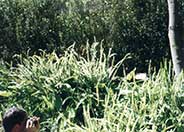
Common name:Southern Sword Fern
Botanical name:Nephrolepis cordifolia
Nephrolepis cordifolia is tough and easy to grow. This fern has bright green, narrow, upright fronds in tufts to 2'-3' tall. Fronds have closely spaced, finely toothed leaflets.
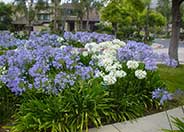
Common name:Lily of the Nile
Botanical name:Agapanthus hybrids
This evergreen groundcover/shrub will grow about 3' tall and has large green leaves with blue flowers (there is a white variety and dwarf varieties) that bloom in spring and summer. It will grow in all soils but prefers loam soil.

Common name:Bahia Hybrid Daylily
Botanical name:Hemerocallis 'Bahia'
This Daylily has yellow flowers. It prefers full sun. It looks best in mass plantings.
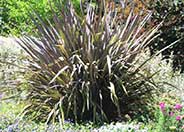
Common name:New Zealand Flax, Purple
Botanical name:Phormium tenax 'Atropurpureum'
Phormium tenax 'Atropurpureum' is an evergreen perennial. Big, dramatic plant composed of many swordlike, stiffly vertical leaves can reach 5' tall. Leaves are purple red. Flowers stems reach high above leaves, bearing clusters of 1"-2" blossoms in dark red.
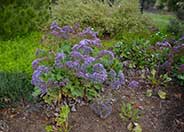
Common name:Sea Lavender, Statice
Botanical name:Limonium perezii
This mounding shrub will reach about 3' high and has large, dark green leaves with small blue and purple flowers that bloom in spring and summer.
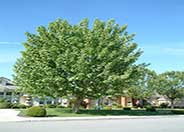
Common name:California Sycamore
Botanical name:Platanus racemosa
The California Sycamore is a fast growing deciduous tree that reaches up to 40'-50' high. It tolerates heat, smog, and drought conditions as well as moist conditions; it is native to riparian areas. It has interesting mottled bark when the tree is bare in winter.
Dealing With Drought
More than half of the water used at your home is for outside purposes. Studies show that on average, half of the water used outdoors is wasted. The leading cause of waste is incorrectly set and poorly managed irrigation controllers. The second biggest cause of wastage is broken irrigation equipment that goes undetected. There are a few basic things you can do to make a big difference in your water use.
Click in the green box for more information
| Designer: | Lush and Green Under the Sycamore |
Photographer: GardenSoft |
Soils and Compost:
Incorporate compost 6" into your soil to retain water, reduce compaction, feed earthworms, and provide valuable nutrients to your plants.
Water Saving Tip:
Mulching and adding compost to soil can minimize evaporation and help soil absorb and store water.
Integrated Pest Management:
Attract, or buy beneficial insects such as ladybugs and lacewings to control pest outbreaks in your garden.

